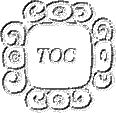
The Mayan calendar round is based upon two important cycles: the 260 ritual cycle and the 365 day vague year. The 260 day cycle consists of the complete cycle constructed by the interlocking of the first 13 numbers with the 20 named days, as seen in the diagram below.

Because the two sequences are of unequal length (13 & 20), when the cycle of length 13 ends the first time, the fourteenth day, Ix, aligns with the number 1. Therefore the sequence at the beginning of the 260 day cycle is:
To complete the calendar round the date as given by the 260 day cycle is matched with the day given by the solar year, the Mayan Vague Year. This year is 365 days is long. The Mayans, while recognizing that this was not quite correct and correcting for the fact in important astronomical calculations, used only whole days in their calendar. The Vague Year date was formed in the same way as the 260 year cycle, using 18 months of 20 days each plus a short month of 5 days, which were considered unlucky, at the end of the year. The last day of each month, instead of being labeled 20, was given a special symbol, indicating the seating of the month about to begin. This was to indicate the fact that the influence of the next month could be felt before it actually began.
If these two cycles are begun at the same time, a period of approximately 52 years (18,980 days) will pass before all of the cycles are back in the same alignment. This cycle is called the Calendar Round and is the calendar still in use by the people in the highlands of Mexico. It has obvious shortcomings when periods longer than 52 years are to be recorded. This problem is dealt with by the long count.
Recommend this site to a friend!
 Return to the Table of Contents
Return to the Table of Contents